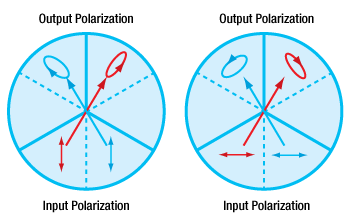レトロリフレクターの実験データ


Please Wait
当社で行った特性確認実験: レトロリフレクタによる偏光状態の変化
当社のレトロリフレクタを透過したビームの偏光状態の測定結果です。偏光依存の実験においては、入射ビームの偏光状態がレトロリフクレタによってどのように変化するかを理解することが重要です。レトロリフレクタの基板に垂直方向に入射したビームは約55°の入射角でプリズムの各表面に当たります[1]。s波とp波には反射表面によって異なった位相遅れが生じ、それぞれ分岐します。レトロリフレクタの基板は六分儀として考えます。六分儀の1つに入射したビームは対頂角にあるもう一方に再帰反射します(右図をご覧ください)。偏光状態の変化はビームの初期偏光条件と入射した六分儀に依存します。
実験には安定化HeNeレーザHRS015(旧製品)を使用しました。ビームをØ25.4 mm(Ø1インチ)N-BK7プリズムレトロリフレクタに透過させ、偏光子を透過後の光出力を測定しました。出力測定は、偏光子を水平、垂直、そして±45°の方向に置いた状態で行いました。次に、光路上の偏光子の前に1/4波長板をファスト軸を水平にアライメントした状態で設置しました。この時の光出力は偏光子を±45°に設置した状態で記録しました。計6つの測定値からストークスパラメータを算出したところ、楕円偏光となりました。
下はレトロリフクレタを透過した偏光の測定結果の概略図です。左下は垂直方向に偏光したビームを入射した場合の出射ビームを、右下は水平方向に偏光したビームを入射した場合の出射ビームの偏光状態を、それぞれ六分儀で示しています。この図の下をさらにクリックしていただくとご覧になれる図では、Aは楕円偏光の長軸を、Bは短軸を表します。Θは水平線から長軸までの角度です。矢印は偏光の方向を示しています。Θ と方向はともににレトロリフクレタ内を見た観測者が報告しています。この測定結果により、レトロリフレクタを透過したビームの偏光状態は、入射されたビームの初期偏光条件だけではなく、ビームが入射した六分儀によって変化することを立証しています。この実験に使用された装置や実験結果の詳細はこちらをクリックしてご覧ください。
参考文献
レトロリフレクタの偏光状態の変化は様々な方法によって研究されてきました。固有偏光状態[2 - 4]、内部反射による変化を利用した内部入射角[5]、ならびに解析幾何学[1]です。こちらでは、レトロリフクレタを透過したビームの偏光状態の実験結果を示し[1]の理論と比較しました。
[1] J. Liu and R. M. A. Azzam, "Polarization properties of corner-cube retroreflectors: theory and experiment," Applied Optics 36, 1553-1559 (1997).
[2] E. R. Peck, "Polarization properties of corner reflectors and cavities," J. Opt. Soc. Am. 52, 253-257 (1962).
[3] P. Rabinowitz, S. F. Jacobs, T. Shultz, and G. Gould, "Cube-corner Fabry-Perot interferometer," J. Opt. Soc. Am. 52, 452-453 (1962).
[4] P.I Lamekin, "Intrinsic polarization states of corner reflectors," Sov. J. Opt. Tech. 54, 658-661 (1987).
[5] M. A. Acharekar, "Derivation of internal incidence angles and coordinate transformations between internal reflections for corner reflectors at normal incidence," Opt. Eng. 23, 669-674 (1984).
| Posted Comments: | |
sam
(posted 2018-08-09 17:42:18.063) Hi:
This applies to retro-reflectors / cube corners / trihedral prisms that are NOT metal-coated on their rear surfaces.
Where the rear faces are metal coated, be it aluminum, copper, or silver, there is much less of an effect on polarization. Based on simple experiments, a linearly polarized input beam is shifted clockwise or counterclockwise by order of 10 degrees depending on which faces are in the beam path.
So:
1. It would be nice to have a similar presentation for the metal-coated retro-reflectors
2. It would be desirable to offer these since many interferometer and other applications depend on minimizing changes to the polarization state.
Thanks,
--- sam
www.repairfaq.org/sam/laserfaq.htm YLohia
(posted 2018-08-21 12:13:06.0) Hello Sam, thank you for your valuable feedback. Metal coated retroreflector prisms are something we are already looking into and I have posted your comment on our internal forum for further consideration. I will reach out to you directly to get a better sense of your application and requirements. |
 Products Home
Products Home




 レトロリフレクタ
レトロリフレクタ